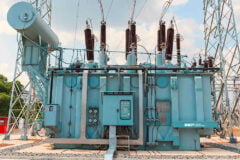Flow Of Electrical Energy
Every electrical system confines electric current flow to selected paths by surrounding the conductors with insulators of various types.

Short circuit current is the flow of electrical energy that results when the insulation barrier fails and allows current to flow in a shorter path than the intended circuit.
In normal operation, the impedances of the electrical appliance loads limit the current flow to relatively small values, but a short circuit path bypasses the normal current-limiting load impedance.
The result is excessively high current values that are limited only by the limitations of the power source itself and by the small impedances of the conductive elements that still remain in the path between the power source and the short circuit point.
In short circuit calculations, the contribution of current sources is first determined, and then the current-limiting effects of impedances in the system are considered in determining how much current can flow in a particular system part.
There are three basic sources of short circuit currents:
- The electrical utility
- Motors
- On-site generators
There are two types of motors that contribute short circuit current:
- Induction motors
- Synchronous motors
Between these sources of short circuit current and the point of the short circuit, various impedances act to limit (impede) the flow of current and thus reduce the actual amount of short circuit current “available” to flow into a short circuit.
Naturally, the value of these impedances is different at every point within an electrical system; therefore, the magnitudes of short circuit currents available to flow into a short circuit at different places within the electrical system vary as well.
For example, it is common to ignore the impedance effect of cables except for locations where the cables are very long and represent a large part of the overall short circuit current path impedance.
Accordingly, in the most common form of short circuit calculations, short circuit current is considered to be produced by generators and motors, and its flow is considered to be impeded only by transformers and reactors.
The Ability of the Electrical Utility System to Produce Short Circuit Current
By definition, the source-fault capacity is the maximum out-put capability the utility can produce at system voltage.
Generally, this value can be gotten from the electrical utility company by a simple request and is most often given in amperes or kilovoltamperes.
Suppose that the utility company electrical system interface data are given as:
MVAsc = 2500 at 138 kilovolts (kV) with an X/R = 7 at the interface point
The short circuit value from the electrical utility company will be “added to” by virtue of contributions from the on-site generator and motor loads within the plant or building electrical power system.
That is, the short circuit value at the interface point with the electrical utility will be greater than just the value of the utility contribution alone.
Resource: EC&M’s Electrical Calculations Handbook – John M. Paschal, Jr., P.E.











short circuit cause accident sometimes. so should careful about it.